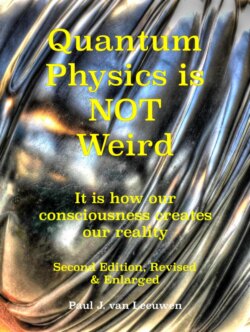Читать книгу Quantum Physics is NOT Weird - Paul J. van Leeuwen - Страница 37
На сайте Литреса книга снята с продажи.
Observing the slits .. or not
ОглавлениеWhen we set up the experiment in such a way that we can observe the particle passing through the slit, the double-slit interference pattern disappears, and we will see an intensity distribution like figure 5.6, the bold grey curve. This curve is the summation of the intensity distributions of two single slits, the thin black curves. This is clearly not an interference pattern. The result looks now as if we had individual waves alternatingly going through only one of the two slits.
Figure 5.6: Intensity distribution with double-slit with both slits open and observing through which slit the photon or electron passed.
In summary: when you don't observe the slits, you will get the figure 5.4 interference and the particles will behave like waves passing through both slits. But as soon as you try to observe the particles passing through the slits, the interference disappears, and each photon or electron behaves like a wave passing through only one of the slits, figure 5.6.
The set-up of the measurement procedure, especially concerning information about which way a particle went, apparently determines which of these two mutually exclusive events will happen; waves passing through two slits or waves passing alternately through a single slit. It is tried to explain this effect by assuming that doing a measurement always means that you exercise a physical influence – no matter how small – on the measured system. We will see why that cannot be the case.
But it turns out to be even weirder. We only need to observe just one of the two slits – it doesn't matter which – to make the interference pattern disappear completely like in figure 5.6. Which means that, when we can infer from our measurement that the particle did pass the unobserved slit, the interference pattern disappears also. Without physically touching or even merely observing the particle! This clearly contradicts the assumption of physical disruption by the measurement of the particle. The wave behavior of the particle seems to be influenced by our observation combined with the knowledge that we did fire a particle. In other words, the information we possess exerts an influence upon the wave behavior of photons and electrons. This is probably not restricted to only photons and electrons.
This is where the most interesting and controversial aspect of quantum physics manifests itself most clearly: the influence of information, presumably residing in the mind of the observer, on the physical world. This is the key question: How is it possible that, when we receive and/or have information about certain aspects of the particle, that this information is enough to exert a physical material effect? What does it mean when we speak about information?
A lot of literature and film about the double-slit experiments speaks about the wave-particle duality as if observing the slit causes the change of the wave into the particle. These authors are confusing the issue. Observing the slit causes the wave – whether electron or photon – to behave differently. It is still a wave, however. The wave is not changing into a particle at the observed double slit. Only at the instant when the wave hits the screen, not before, it is the particle that is observed. That is the correct description of the particle-wave duality.
To be frank with you, when I started to try to understand the meaning of the double slit experiment with electrons I was confused too and called the outcome of the observed double slit experiment proof of particle behavior. This will turn out to be defensible in a certain way. We will see that the fact that the quantum wave passes through only one of the slits informs us that the probability that the particle was at some time in that slit, is 100%. A probability of 100% is in fact the same as saying that the particle was in the slit. But was it there in a physical way?
